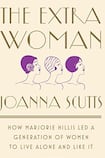
In the late summer of 1936, visitors to department stores all over America were greeted by glamorous displays celebrating the work of a woman called Marjorie Hillis. The displays showcased negligees, cosmetics, tea gowns, cocktail shakers – every little luxury an elegant woman could desire. But Hillis wasn't a designer or the head of a cosmetics empire. She was an editor at Vogue magazine, and the displays were celebrating her new book, an amusing little volume which became one of 1936's most talked-about bestsellers.
The book was called Live Alone and Like It: A Guide for the Extra Woman, and in it Hillis, then aged 46 and unmarried, offered women who lived alone (either by necessity or desire) advice and encouragement on how to create and enjoy the life they wanted – and how to do it in style. Society had always viewed single women as a problem, an embarrassment or a joke. But as Joanna Scutts points out in this fascinating and hugely entertaining book, by 1936, things were changing.
The Depression had thrown previous notions of independence and suitable employment up in the air – and that wasn't always a bad thing for women. Although the Depression had devastated predominantly male domains such as heavy industry; traditionally female roles – teachers, nurses, garment workers, lowly office staff – were still needed. Both single and married women discovered what it was like to have an income of their own – albeit a small one (Hillis's second book, Orchids On Your Budget, was a guide to living stylishly within one's means).
Scutts is a British writer and historian based in New York, and perhaps this is why she’s able to so carefully observe the uniquely American individualism with which the nation responded to the Depression. She points out that while the New Deal was based on a spirit of solidarity (for white Americans anyway), the self-help writers whose books sold by the thousands during this period “encouraged readers to see their own individual, indomitable will as the essence of their identity as Americans, and key to their success”.
Hillis presented life as a Live-Aloner as one of fun and liberation – although she stressed the importance of friends, family and social engagement
Hillis's book was part of that movement, but its humour and stealthy feminism made it a more radical book than contemporary titles such as Dale Carnegie's How To Win Friends and Influence People. As Scutts points out, "Marjorie's message, that single women could work, play and live exactly as they chose, was nothing short of revolutionary, although its trappings were lighter than air".
Hillis presented life as a Live-Aloner (her own term) as a life of fun and liberation – a life lived for oneself, not devoted to the needs of others. Throughout it and Hillis’s subsequent books, however, she stressed the importance of friends, family and social engagement – the Live-Aloner was happy with her own delightful company, but she wasn’t selfish or isolated.
Scutts uses Hillis's writing, from Live Alone to her final book, 1967's Keep Going And Like It, to trace the social and cultural history of single women's status in America in the 20th century. On the way she wittily and insightfully explores the cultural significance and influence of everyone from groundbreaking designer Dorothy Draper to fictional singleton heroines such as Auntie Mame.
Crucially, Scutts regularly reminds her readers that structural racism meant that many social advancements applied to white American women only, and she shows how African-American women had to forge their own ways of being independent (I’d love to know even more about the Emma Ransom House, the African-American equivalent of the famous Barbizon Hotel (aka Barbizon 63), which offered young women a comfortable and respectable place to live in New York City).
Having become an icon of single womanhood, at the age of 49 Marjorie Hillis caused a sensation when she married a wealthy widower called Harry Roulston. There are frustratingly few details in the book about Hillis's (clearly happy) married life, because as Scutts says "marriage effectively silenced [her]" – she published almost nothing during the 10 years of her marriage. After Roulston's death, however, Hillis pulled herself together and wrote more bestsellers, including 1951's You Can Start All Over. She died in 1971, but as Scutts reminds us, her audacious celebration of female independence can still amuse and inspire us today. She and Scutts's wonderful book should be toasted with well-mixed cocktails.
Anna Carey's latest novel is The Making of Molly










